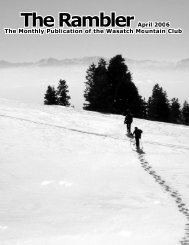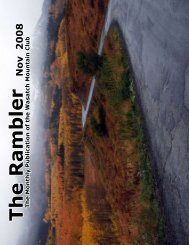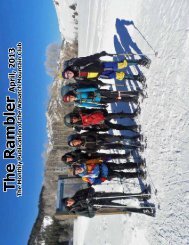Rambler
Jan - Wasatch Mountain Club
Jan - Wasatch Mountain Club
- No tags were found...
Create successful ePaper yourself
Turn your PDF publications into a flip-book with our unique Google optimized e-Paper software.
All that is necessary for an avalanche is a mass of snow and a slope for it to slide down. For<br />
example, have you ever noticed the snowpack on a car windshield after a snowfall? While the<br />
temperature is cold, the snow sticks to the surface and doesn’t slide off. After temperatures<br />
warm up a little, however, the snow will “sluff”, or slide, down the front of the windshield, often<br />
in small slabs. This is an avalanche on a miniature scale.<br />
Of course, mountain avalanches are much larger and the conditions that cause them are more<br />
complex. A large avalanche in North America might release 300,000 cubic yards of snow.<br />
That’s the equivalent of 20 football fields filled 10 feet deep with snow. However, such large<br />
avalanches are often naturally released. Skiers and recreationists are usually caught in smaller,<br />
but often more deadly avalanches.<br />
Slab avalanches are the most common and most deadly avalanches, where layers of a snowpack<br />
fail and slide down the slope. Since 1950, 235 people in the U.S. have been killed in<br />
slab avalanches. Hard slab avalanches involve large blocks of snow and debris sliding down a<br />
slope. In soft slab avalanches, the snow breaks up in smaller blocks as it falls.<br />
An avalanche has three main parts. The<br />
starting zone is the most volatile area of a<br />
slope, where unstable snow can fracture from<br />
the surrounding snow cover and begin to slide.<br />
Typical starting zones are higher up on slopes,<br />
including the areas beneath cornices and<br />
“bowls” on mountainsides. However, given<br />
the right conditions, snow can fracture at any<br />
point on the slope.<br />
The avalanche track is the path or channel<br />
that an avalanche follows as it goes downhill.<br />
When crossing terrain, be aware of any slopes<br />
that look like avalanche “chutes”. Large vertical<br />
swaths of trees missing from a slope or<br />
chute-like clearings are often signs that large<br />
avalanches run frequently there, creating their<br />
own tracks. There may also be a large pile-up<br />
of snow and debris at the bottom of the slope,<br />
indicating that avalanches have run.<br />
The runout zone is where the snow and debris finally come to a stop. Similarly, this is also<br />
the location of the deposition zone, where the snow and debris pile the highest. Although<br />
underlying terrain variations, such as gullies or small boulders, can create conditions that will<br />
bury a person further up the slope during an avalanche, the deposition zone is where a victim<br />
will most likely be buried. (From nsidc.org)<br />
14
















